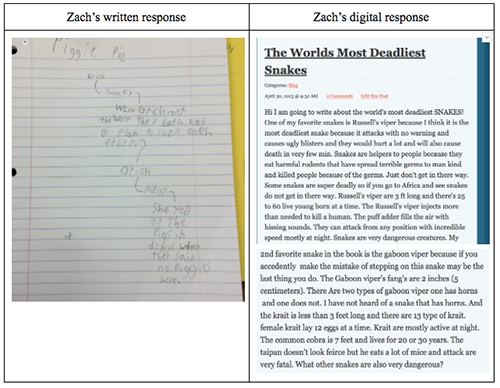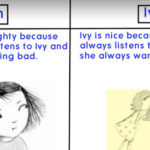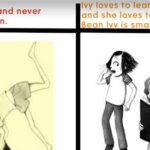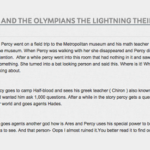Chapter 6: Supporting Diverse Learners
6.4 Writing About Reading: A New Road to Travel
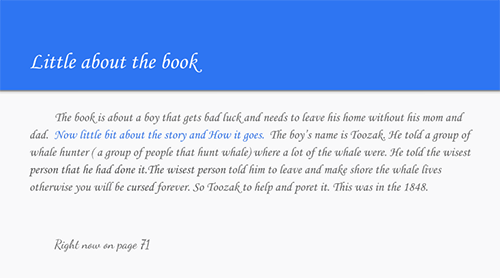
As a reader I use technology to sustain my reading life. I use Twitter to learn about the latest books to share with students as well as what to read professionally. I’ve sent tweets to authors to share my thoughts about their writing. I also use Goodreads to help keep track of the books I have read and books I want to read. I blog about books and I read blogs about books. I have created and participated in online book communities. Digital literacy is still new to me and I continue to explore new tools and spaces to share, reflect and push my reading life. However, my students were only using traditional tools to sustain their reading lives and our reading community. They needed more opportunities to grow as readers. So I thought about tools students could use to share their thinking about books. In writing workshop we were using technology to share our work with with a larger audience, so why weren’t we doing that in reading workshop when we write about our reading?
I knew that I did not want to have everyone learn new digital tools at the same time. I wanted to use the tools to demonstrate and model the possibilities in my mini-lessons. If I took the time to teach each technology tool and decided on a project to do with each tool then we would lose valuable independent reading time. I wanted the students to make the following decisions; which book to discuss, what was important to share about that book, and to decide which tool (traditional or digital) would best communicate their ideas.
The students had some digital tools that they were already using flexibly in our workshops. I wanted to introduce them to a new tool that had some different features to help express their ideas. I wanted something that would allow the students to either record their thinking or they could insert a text box. It was important for my English Language Learners to be able to either choose to write down their thinking or record their thinking. Some students had more control over speaking English than expressing their ideas in writing. Students needed to be able to take photos or insert photos to help share their thinking because not all students love to draw. Some students enjoyed creating multiple slides to express their thinking so I needed another tool that would allow them to organize their thinking by slides if they chose to. All the students enjoyed sharing their thoughts with the classroom and also with a wider audience. It was important to have a tool that allowed students to share in the classroom and through social media to reach a larger audience. I needed a digital tool that I could use for shared writing and to express whole class thinking instead of using our traditional anchor charts. Another digital tool I found that would help me demonstrate learning and also fit the various needs of my students was called Explain Everything.
I decided to use this tool in my next mini-lesson on how readers grow theories about characters. We have been talking about how to use evidence from the text or book to support our thinking and help us grow our ideas about characters. I used our chapter book read aloud titled The Miraculous Journey of Edward Tulane by Kate DiCamillo. Edward is the main character in the book and we were thinking of precise words to describe him. I took a photo from a page in the book that we could use to describe what Edward was like. I projected the image onto the board so everyone could see it. As a class were were able to discuss a trait and find evidence to highlight on the photo. We could insert a text box for shared writing. We crafted our thoughts together about Edward and then talked about how this is another tool to use when you write about your reading. I would continue to use this tool over the next few days in our mini-lessons about characters.
At first only one or two students tried to use this digital tool to share their thinking about their books. Rana who is an English Language Learner I mentioned earlier wrote about Mercy Watson at home and then brought in her writing to use this digital tool to share her thoughts about the book. First she shared with the class and then we imported her work into her blog for a wider audience to read.
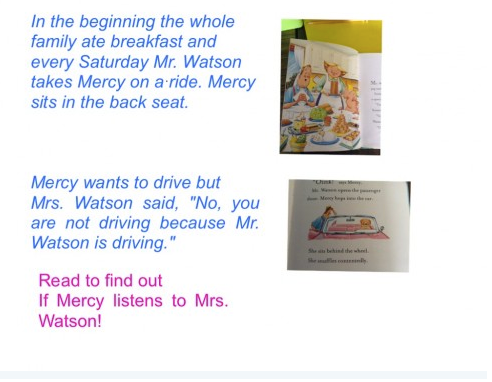
I had to keep in mind that the students were learning the tool at the same time they were writing about what they thought was important to share. This did slow down their time to craft a response. They would need time to write down their thoughts and then figure out which pictures to use in their digital piece. They might try and record their thinking on a slide or page. The students needed time to revise and edit their work if they were posting on their blog. Some students started to ask if they could use Pixie to share their writing about their reading because they were familiar with that digital tool. When students started choosing different tools more consistently in the workshop I noticed them wanting to write more about the books they were reading. The technology tools gave them more options to take ownership of their work. Students trying new things helped other students see new possibilities when writing about their reading. I wanted the enthusiasm and options to come from the students not from me.
Students trying new things helped other students see new possibilities when writing about their reading.
Our whole group share time at the end of reading workshop would be another opportunity for students to see how to use technology as readers. Students could use Airserver to share their work on the iPad and we could share multiple screens at once. Students could see the different tools and messages from each reader. There were days where we shared about our reading with traditional tools, and there were days where there was a mixture of both because it all depended on what the students choose to use and the purpose of their work. It was important to focus our conversations when sharing these pieces on the process and not the product. The tools were a vehicle to display their work but it was important to understand the strategies readers used to get them there. I asked some of the following questions: Why did you choose to talk about that part of the book? What evidence did you use to support your thinking? What else did you notice? Can you tell me more? I used these questions to guide students’ thinking whether they used traditional or digital tools. The biggest thing the students needed to think about was audience. Did they want to share this book and thoughts with just our reading community or did they want a larger audience?
I decided to encourage technology use in my guided reading groups. When we were writing about our reading I let them choose to compose their thoughts on paper or they could use a digital tool. Interestingly, I discovered that students typically chose their response journals when writing about their reading from our group work and chose digital tools to write about their reading with their independent books. I really started to see how voice and choice were key to the students owning their learning.
As an example, Zach was a student who had great reading stamina but needed to work on writing stamina. He did a wonderful job of sharing his reading thinking orally but needed support when communicating his ideas using written expression. Zach was aware that he needed to work on writing about his reading. When he would write in his response journal Zach would rush to get his ideas down so that he could go back to reading. After many conferences I still noticed his responses were the same and we still focused on including more evidence or details. I kept wondering how I could help Zach shift and get him more motivated to write about his reading. Throughout the year we make reading goals to reflect and push ourselves as readers. Zach’s goal for himself was to write more about his reading.
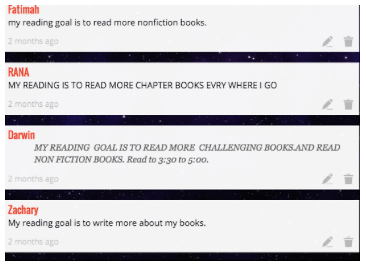
He started using digital tools to help him achieve his goal. Zach slowed down his work pace to spend more time on responses and he started to add more details about the book. I was amazed at the differences in his responses and how he was more motivated to write about reading when he could choose what to say and which tool to use.
